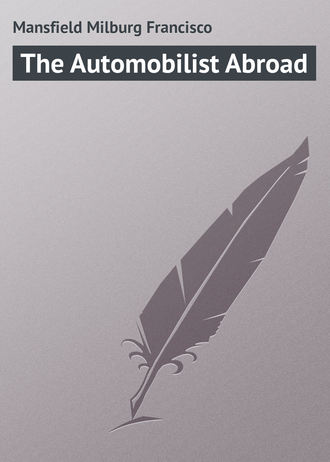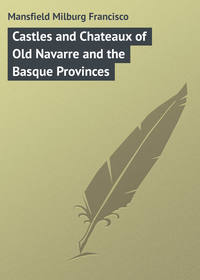 полная версия
полная версияThe Automobilist Abroad
Under Louis XIV., Colbert continued the good work and put up the first mile-stone, or whatever its equivalent was in that day, measuring from the Parvis de Notre Dame at Paris. Some of these Louis XIV. bornes, or stones, still exist, though they have, of course, been replaced throughout by kilometre stones.
The foregoing tells in brief of the natural development of the magnificent roads of France. Their history does not differ greatly from the development of the other great European lines of travel, across Northern Italy to Switzerland, down the Rhine valley and, branching into two forks, through Holland and through Belgium to the North Sea.
In England the main travel routes run north, east, south, and west from London as a radiating centre, and each took, in the later coaching days, such distinctive names as "The Portsmouth Road," "The Dover Road," "The Bath Road," and "The Great North Road." Their histories have been written in fascinating manner, so they are only referred to here.
It is in France, one may almost say, that automobile touring begins and ends, in that it is more practicable and enjoyable there; and so la belle France continually projects itself into one's horizon when viewing the subject of automobilism.
It may be that there are persons living to-day who regret the passing of the good old times when they travelled – most uncomfortably, be it remarked – by stage-coach and suffered all the inclemencies of bad weather en route without a word of protest but a genial grumble, which they sought to antidote by copious libations of anything liquid and strong. The automobile has changed all this. The traveller by automobile doesn't resort to alcoholic drinks to put, or keep, him in a good humour, and, when he sees a lumbering van or family cart making its way for many miles from one widely separated region to another, he accelerates his own motive power and leaves the good old ways of the good old days as far behind as he can, and recalls the words of Sidney Smith:
"The good of other times let others state,I think it lucky I was born so late."A certain picturesqueness of travel may be wanting when comparing the automobile with the whirling coach-and-four of other days, but there is vastly more comfort for all concerned, and no one will regret the march of progress when he considers that nothing but the means of transportation has been changed. The delightful prospects of hill and vale are still there, the long stretches of silent road and, in France and Germany, great forest routes which are as wild and unbroken, except for the magnificent surface of the roads, as they were when mediæval travelers startled the deer and wild boar. You may even do this to-day with an automobile in more than one forest tract of France, and that not far from the great centres of population either.
The invention of carriage-springs – the same which, with but little variation, we use on the automobile – by the wife of an apothecary in the Quartier de St. Antoine at Paris, in 1600, was the prime cause of the increased popularity of travel by road in France.
In 1776, the routes of France were divided into four categories:
1. Those leading from Paris to the principal interior cities and seaports.
2. Those communicating directly between the principal cities.
3. Those communicating directly between the cities and towns of one province and those of another.
4. Those serving the smaller towns and bourgs.
Those in the first class were to be 13.35 metres in width, the second 11.90, the third 10, the fourth 7.90. The road makers and menders of England and America could not get better models than these.
The advent of the automobile has brought a new factor into the matter of road making and mending, but certainly he would be an ignorant person indeed who would claim that the automobile does a tithe of the road damage that is done by horse-drawn traffic.
At a high rate of speed, however, the automobile does raise a fine sandy dust, and exposes the macadam. A French authority states that up to twenty to twenty-five kilometres an hour the automobile does little or no harm to the roads, but when they increase to over fifty kilometres an hour they do damage the surface somewhat. Just what the ultimate outcome of it will be remains to be seen, but France is unlikely to do anything which will work against the interests of the automobilist.
In consequence of this newer and faster mode of travelling, it is being found that on some parts of the roads the convexity of the surface is too great, and especially at curves, where fast motors frequently skid on the rounded surface. To obviate this a piece of road near the Croix d'Augas in the Orleannais has had the outer side of the curve raised eight centimetres above the centre of the road, in somewhat the same manner as on the curve of a railway. Since this innovation has proved highly successful and pleasing to the devotees of the new form of travel, it is likely to be further adopted.
In the early period of the construction of French roads the earth formation was made horizontal, but Trésaguet, a French engineer, introduced the rounded form, or camber, and this is the method now almost generally adopted, both in France and England. Only some 14,000 kilometres of the national routes have a hand-set foundation, the others being what are termed broken-stone roads – the stone used is broken in pieces and laid on promiscuously, after the system introduced by Macadam. Some of the second and third class, roads are constructed of gravel, and others, of earth.
From the official report of 1893 it appears that the cost of maintenance of roads in France was as follows:

The above is for materials and labour on the roadways only, and something between 33 1/3 per cent, and 50 per cent. is added for the maintenance of watercourses and sidewalks, the planting of trees, and for general administrative expenses.
Excepting for twenty kilometres or so around Paris, the vehicular traffic on the country roads of France does not seem to be in any way excessive. The style of vehicles in France that carry into the cities farm and garden produce, wood, stone, etc., are large wagons with wheels six to seven feet in diameter. These wagons are more easily hauled and naturally do less damage to the roads than narrow-tired, low-wheeled trucks or drays. The horses in Paris, and in the country, are nearly all plain shod, with no heels or toes to act like a pick to break up the surface. Sometimes even one sees draught-horses with great flat, iron shoes extending out beyond the hoof in all directions.
The question of the speed of the automobile on the roads, in France and England, as indeed everywhere else, has been the moot point in all legislation that has been attempted.
The writer thinks the French custom the best. You may legally go at thirty kilometres an hour, and no more. If you exceed this you do it at your own risk. If an accident happens it may go hard with you, but if not, all is well, and you have the freedom of the road in all that the term implies. In the towns you are often held down to ten, eight, or even six kilometres an hour, but that is merely a local regulation, for your benefit as much as for the safety of the public, for many a French town has unthought-of possibilities of danger in its crooked streets and unsafe crossings.
Good roads have much to do with the pleasure of automobilism, and competent control and care of them will do much more. Where a picked bit of roadway has been chosen for automobile trials astonishing results have been obtained, as witness the Gordon-Bennett Cup records of the last six years, where the average speed per hour consistently increased from thirty-eight miles to nearly fifty-five, and this for long distances (three hundred and fifty miles or more).
To meet the new traffic conditions the authorities must widen the roads here and there, remove obstructions at corners, make encircling boulevards through narrowly laid out towns, and erect warning signs, like the following, a great deal more numerously than they have as yet.
They have very good automobile laws in France in spite of their anomalies. You agree to thirty-seven prescribed articles, and go through sundry formalities and take to the road with your automobile. In the name of the President of the Republic and the "peuple français," you are allowed thirty kilometres an hour in the open country, and twenty in the towns. You can do anything you like beyond this – at your own risk, and so long as no accident happens nothing will be said, but you must pull up when you come to a small town where M. le Maire, in the name of his forty-four electors, has decreed that his village is dangerously laid out for fast traffic, – and truth to tell it often is, – and accordingly you are limited to a modest ten or even less. It is annoying, of course, but if you are on a strange itinerary you had best go slow until you know what trouble lies ahead.
In theory la vitesse is national in France, but in practice it is communal, and the barriers rise, in the way of staring warnings posted at each village-end, like the barriers across the roads in the times of Louis XI.
Except in Holland, where some "private roads" still exist, and in certain parts of England, the toll-gate keeper has become almost an historical curiosity. It is true, however, that in England one does meet with annoying toll-bridges and gates, and in France one has equally annoying octroi barriers.
One recognizes the vested proprietary rights, many of which, in England, are hereditary, of certain toll-gates and bridges, but it is hard in these days, when franchises for the conduct of public services are only granted for limited periods, that legislation, born of popular clamour, should not confiscate, or, better, purchase at a fair valuation, these "rights," and make all roads and bridges free to all.
In France there are no toll-gates or bridges, or at least not many (the writer recalls but one, a bridge at La Roche-Guyou on the Seine, just above Vernon), but there are various state ferries across the Seine, the Rhône, the Saône, and the Loire, where a small charge is made for crossing. These are particularly useful on the lower Seine, in delightful Normandy, as there are no bridges below Rouen.
In France one's chief delays on the road are caused by the octroi barriers at all large towns, though only at Paris and, for a time, at St. Germain do they tax the supplies of essence (gasoline) and oil, which the automobilist carries in his tanks.
The octroi taxes are onerous enough in all conscience, but it is a pity to annoy automobilists in the way the authorities do at the gates of Paris, and it's still worse for a touring automobile to be stopped at the barrier of a town like Evreux in Normandy, or Tarare in the Beaujolais. Whatever does the humble (and civil, too) guardian do it for, except to show his authority, and smile pleasantly, as he waves you off after having brought you to a full stop at the bottom of a twisting cobble-stoned, hilly street where you need all the energy and suppleness of your motor in order to reach the top.
There are not many of these abrupt stops, outside the large towns, and nowhere do they tax you on your oil or essence except at Paris – where you pay (alas!) nearly as much as the original cost.
At Rouen the guardian comes up, looks in your tonneau to see if you have a fish or a partridge hidden away, and sends you on your way with a bored look, as though he disliked the business as much as you do. At Tours, if you come to the barrier just as the official has finished a good lunch, he simply smiles, and doesn't even stop you. At Marseilles you get up from your seat and let the official poke a bamboo stick down among your chambres d'air, and say nothing – provided he does not puncture them; if he does, you say a good deal, but he replies by saying that he was merely doing his duty, and meant no harm.
At Nantes, at Rennes, at Orleans, and Bordeaux, all of them grandes villes, every one is civil and apologetic, but still the procedure goes on just the same.
At Lyons the octroi tax has been abolished. Real progress this!
In the old coaching days road speeds fell far behind what they are to-day in a well-constructed and capable automobile, but, as they put in long hours on the road, they certainly did get over the ground in a fairly satisfactory manner. Private conveyances, with private horses, could not hope to accomplish anything like it, simply because there is a limit to the working powers and hours of the individual horse. With the old mail-coaches, in England, and the malle-poste and the poste-chaise, in France, things were different, for at every poste, or section, was a new relay; and on the coach went at the same pace as before.
The London-Birmingham coaches in 1830 covered the 109 miles between the two points at an average speed of 15.13 miles per hour, the highest speed being eighteen, and the lowest eleven miles.
In France the speeds were a little better. From Lyons the old mail-coaches used to make the journey to Paris in four days by way of Auxerre, and in five by Moulins, though the distance is the same, one hundred and twenty leagues. To-day the automobile, which fears not hills, take invariably the Moulins road, and covers the distance between breakfast and dinner; that is, if the driver is a "scorcher;" and there are such in France.
In 1834 there were thirteen great lines of malle-postes in France as follows:
To Calais. By Clermont, Amiens, and Abbeville.
To Lille. By Senlis, Noyon, St. Quentin, Cambrai, and Douai.
To Mezières. By Soissons, Reims, and Rhetel.
To Strasbourg. By Chalons-sur-Marne, Metz, and Sarrebourg.
To Besançon. By Troyes and Dijon.
To Lyon. By Melun, Auxerre, Autun, and Macon.
To Clermont-Ferrand. By Fontainebleau, Briare, Nevers, and Moulins.
To Toulouse. By Orleans, Chateauroux, Limoges, and Cahors.
To Bordeaux. By Orleans, Blois, Tours, Poitiers, and Angoulême.
To Nantes. By Chartres, Le Mans, La Fleche, and Angers.
To Brest. By Alençon, Laval, Rennes, and St. Brieuc.
To Caen. By Bonnières, Evreux, and Lisieux.
To Rouen. By Neuilly-sur-Seine, Pontoise, Gisors, Ecouis, and Fleury-sur-Andelle.
Besides the malle-poste there was another organization in France even more rapid. The following is copied from an old advertisement:
AVIS AU PUBLIC"Messageries Royales – Nouvelles Diligences"Le Public est averti:
"Il partira de Paris toutes les semaines, pour Dunkerque, passant par Senlis, Compiègne, et Noyon, une diligence le lundi à 6 heures du matin. Elle repartira de Dunkerque à Paris, le mercredi à 6 heures du matin. Il partira aussi dans chaque sens une voiture pour les gros bagages et objets fragiles, le jeudi de chaque semaine.
"Les bureaux de ces diligences sont établis à Paris, rue St. Denis, vis-à-vis les Filles-Dieu."
From Paris to Bordeaux, 157 leagues, the Messageries Royales made the going at an easy pace in five days. To-day the express-trains do it in six and one-half hours, and the ever-ready automobile has knocked a half an hour off that, just for a record. "Tempus fugit."
The subject of roads and roadmaking is one that to-day more than ever is a matter of deep concern to those responsible for a nation's welfare.
It might seem, in these progressive days, that it was in reality a matter which might take care of itself, at least so far as originally well-planned or well-built roads were concerned. This, however, is not the case; the railway has very nearly reached the limit of its efficiency (at any rate in thickly settled parts), and the electric roads have merely stepped in and completed its functions.
It is certain that an improved system of road administration or control is needed. The turnpike or the highroad served its purpose well enough in coaching days as the most direct and quickest way between important towns. To-day, in many respects, conditions are changed. Certain centres of population and commercial activity have progressed at the expense of less fortunate communities, and the one-time direct highroads now deviate considerably, with the result that there is often an unnecessary prolongation of distance and expenditure of time.
Examples of this sort are to be found all over Britain, but a great deal less frequently in France, where the communication is by a more direct line between important centres, often leaving the small and unimportant towns out of the itinerary altogether.
In England, centralization or nationalization of the road-building authority should remedy all this. Cuts and deviations from existing lines, for the general good, would then be made without local jealousy or misapplied influence being brought to bear, and the general details of width and surface be carried on throughout the land, under one supreme power, and not, as often now is the case, by various local district and urban councils and county surveyors.
"The Great North Road" and "The Famous Bath Road" vary greatly throughout their length as to width and excellence; and yet popular opinion in the south of England would seem to indicate that these roads, to single them out from among others, are idyllic, both in character of surface and skill of engineering, throughout their length. This is manifestly not so. The "Bath Road," for example, in parts, is as flat and well-formed a surface as one could hope to find, even in France itself, but at times it degenerates into a mere narrow, guttery alley, especially in its passage through some of the Thames-side towns, where the surface is never of that excellence that it should be; throughout its entire length of some hundred odd miles to Bath there are ever-recurring evidence of bad road-making and worse engineering.
One is bound to take into consideration that it is the automobile, and the general increase in automobile traffic, that, in all countries, is causing the wide-spread demand for improved roads.
To illustrate the growth of the use of the automobile on the public highway, and taking France as an example, the following statistics are given from the Journal des Débats:
In 1900 there were taxed in France 1,399 voitures-automobiles of more than two places, and 955 of one or two places. In 1903 the figures had risen to 7,228 and 2,694 respectively. These figures may seem astonishingly small at first glance, but their percentage of growth is certainly abnormally large. These voitures-automobiles, be it recalled, are all pleasure carriages, and displaced in the same time (according to the same authority) 10,000 horse-drawn vehicles. At the same period Paris alone claimed 1,845 voitures-automobiles and 6,539 horse-drawn pleasure carriages.
Road reformers, wherever found, should agitate for two things: the efficient maintenance of existing roads and the laying out of new and improved thoroughfares where needed.
In England and America the roadways are under the care of so many controlling bodies that they have suffered greatly. In England, for example, there is one eighteen-mile strip of road which is under the control of twelve different highway authorities, while the "Great North Road" from London to Edinburgh, is, in England alone, subject to seventy-two separate authorities. Local jealousies, rivalry and factions, and the quarrels of various road authorities interfere everywhere with good roads. The greatest good of the greatest number is sacrificed to village squabbles and to the advice of the local squire, who "detests motor-cars," as he does most other signs of progress. The roads of the future must be under some general control. At present, affairs in England are pretty bad; let America take heed in her new provisions for road supervision and government.
There is at present an almost Chinese jumble in the distribution of authority over roads in England and Wales. There are in London alone twenty-nine highway authorities, and 1,855 throughout the rest of the country.
In view of the fact that through motor traffic of all kinds will increase every year, it has been suggested that new loop roads should be constructed round towns on the chief roads, private enterprise being enlisted by the expectation of improved land value. This certainly would be a move in the right direction.
Mile-stone reform is another thing which is occupying the serious attention of the road user. In Continental Europe this matter is pretty well arranged, though there is frequently a discrepancy of two, three, or even five kilometres between the national mile-stones (bornes kilométriques) and the sign-boards of the various local authorities and touring clubs.
France has the best system extant of sign-boards and mile-stones. One finds the great national, departmental, and communal signs and stones everywhere, and at every hundred metres along the road are the intermediate little white-numbered stones, from which you may take your bearings almost momentarily, with never a fear that you are off your track.
In addition to this the sign-boards of the Touring Club de France, the Automobile Club de France, and the Association Générale Automobile satisfy any further demands that may be made by the traveller by automobile who wants to read as he runs. No such legible signs and warnings are known elsewhere.
There is uniformity in all the kilometre and department boundary stones in France; but in England "mile-stones" of all shapes, sizes, materials, and degrees of legibility are found.
There are some curious relics in the form of ancient mile-stones still in use, which may please the antiquarian, but are of no value to the automobilist. There is the "eightieth mile-stone on the Holyhead Road" in England, which carries one back through two centuries of road travel; and there is a heavy old veteran of perhaps a thousand years, which at one time marked the "Voie Aurelian," as it crossed Southern Gaul. It is found in Provence, in the Bouches-du-Rhône, near Salon, and is a sight not to be missed by those curiously inclined.
The question of dust is one of the chief problems yet to be solved for the benefit of automobilists and the general public alike. A good deal of the "dust nuisance" is due to badly made and badly kept roads, but we must frankly admit that the automobile itself is often the cause. "La Ligue Contre la Poussière," in France, has made some interesting experiments, with the below enumerated results, as related to automobile traffic. Road-builders and manufacturers of automobiles alike have something here to make a note of.
1. Sharp corners and excessive road cambers lead to slip, and, therefore, to dust.
2. More dust is raised on a rough road than on an equally dusty smooth road.
3. Watering the road moderately diminishes the dust.
4. The spreading on the road of crude oil, or of oil emulsions in water, is an important palliative.
5. Wood, asphalt, cobblestones, and square pavings are not dusty save after use by horse traffic.
6. Cars with smooth, boat-shaped under surfaces are less dusty than others.
7. Cars with large mud-guards and leather flaps near the road are more dusty.
8. Cars on high wheels well away from the ground are less dusty.
9. Cars with large tool-boxes at the back reaching low down between the back wheels are dusty.
10. Large car bodies are often dustier than small ones.
11. Blowing the exhaust near the ground increases the dust.
12. Cars fitted with engines having an insufficient fly-wheel or a non-uniform turning effort from any cause are more dusty.
13. A car mounted on very easy springs having a large up-and-down play will suck up the dust with each rise and fall of the body on rough roads.
14. Front wheels – or rolling wheels – raise less dust than back wheels or driving wheels.
15. Smooth pneumatic tires are dusty.
16. Solid or pneumatic rubber tires are more dusty at higher speeds, and with high-powered engines.
17. Non-skid devices, such as small steel studs, etc., do not increase the dust.
A writer on automobilism and roads cannot leave the latter subject without a reference to some of the obstructions and inconveniences to which the automobilist has to submit. If the automobilist proved himself a "road obstruction" like any of the following he would soon be banished and the industry would suffer.









